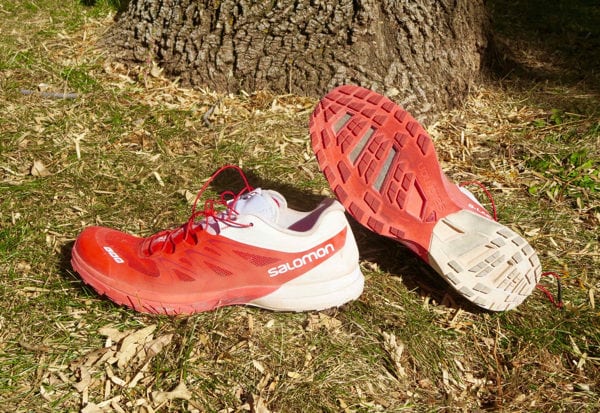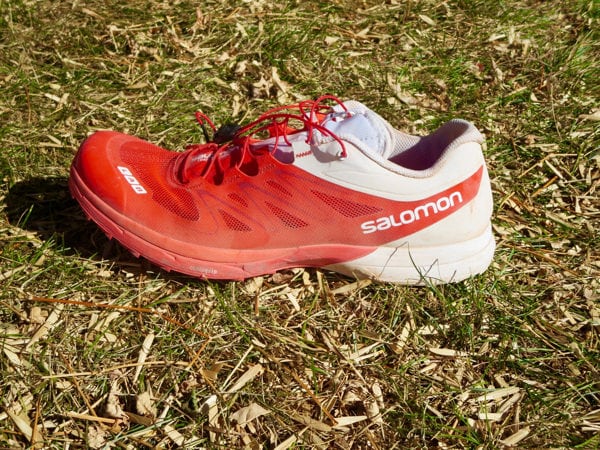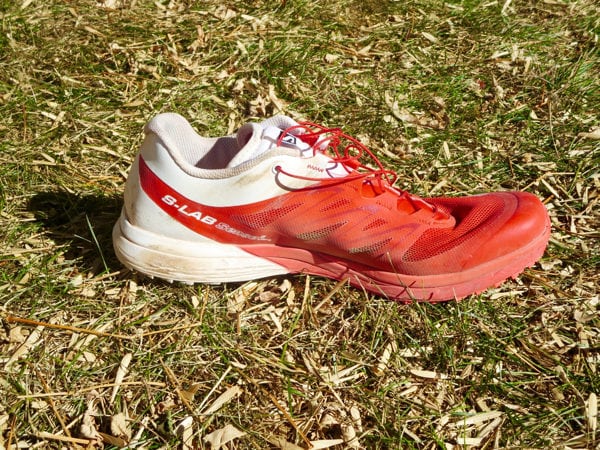Our Favorite Trail Running Shoes
Check out our Best Trail Running Shoes article to learn about our current favorite trail running shoes!
Salomon S-Lab Sense 5 Ultra Review
It is safe to say that the Salomon S-Lab Sense 5 Ultra ($180) may be the most iconic trail running shoe ever designed with an incredibly complicated and wordy name. This simple, yet incredibly refined red-and-white beauty continues to excel at exactly what it was intended for: racing on hard ground and bombing up and down mountains. The Sense Ultra may be the only racing-flat type of shoe designed for trail running in the entire market. Most of us will wear the shoe that we’ve been training in for races and even faster-paced workouts, never giving a thought to the normal road-running practice of doing speed workouts and racing in lighter-weight racing shoes.
The combination of an incredible-fitting upper, racing last, and semi-firm low-drop cushioning make the Sense Ultra a great race-day shoe. However long that distance is really varies by wearer, and the Sense Ultra becomes a shoe that I wish I could wear more often. Some of you were instantly repulsed by the price tag, but when considering the incredible durability and years of use that I’ve gotten out of my past Sense Ultras, this shoe is actually a bargain.
In this review I want to give runners some ideas of why this shoe may be, or maybe not be, right for you. I’ll highlight some of the design changes in this version as well as some of the basic principles that Salomon has long incorporated into this shoe that makes it feel eons ahead of other similar shoes on the market.

The Salomon S-Lab Sense 5 Ultra.
Salomon S-Lab Sense 5 Ultra Upper
I can’t get over it. The red and white. The simple fact that Salomon has never strayed from this color scheme in this, their signature shoe, is absolutely brilliant in my opinion. I don’t think there is a better-looking trail running shoe on the market. While we all know that color doesn’t mean a thing I view it as a fringe benefit of great shoe design.
For those of you who haven’t worn a shoe from the S-Lab series of Salomon shoes, the initial fit can be a bit constricting when you first try to put your foot inside the shoe. Salomon’s Endofit technology is absolutely the best tech on the market to hold your foot securely on technical terrain, and I really can’t say enough positive things about it. Imagine your foot being held by a seamless midfoot wrap that once you’re locked into, you feel absolutely secure yet your toes have enough room to splay and feel the ground, and I had zero issues or hotspots going barefoot for short trail runs. That extra bit of toe-box room is exactly what I find different with the Sense 5 Ultra versus past versions.
Salomon also updates the mesh to be much more breathable, similar to the original model which was designed for Kilian Jornet at Western States in 2011. This mesh is surprisingly durable despite being nearly see-through, although it does allow some dust and sand into the shoe. On very hot days I could even sense the wind having a cooling affect on my toes through the open mesh toe box. This mesh is reinforced throughout the upper rubberized laminate overlays that are also seamless. My favorite part of the entire upper is the rubberized toecap which maintains the structure of the toe box from wrinkling and creating hotspots as well as allowing for just enough protection when you catch a toe. The standard and very effective Salomon Quicklace system with kevlar laces and a lace garage in the tongue of the shoe continue to impress me.

The Salomon S-Lab Sense 5 Ultra lateral upper.
Salomon S-Lab Sense 5 Ultra Midsole
A large part of the reason this shoe holds up so well over time is the triple-density midsole material used on this model. This means you initially experience a very firm ride which softens a bit after about 50 miles. At the outset I had trouble running in this shoe in part due to the fact that I was struggling with some soreness in my forefoot. However, after they broke in, runs in the Sense 5 Ultra felt much smoother and there isn’t a more nimble trail shoe on the market. That being said I max out at about 10 miles in this shoe, and while it is a blast to run in my feet certainly take a beating.
To give you an idea of how firm triple-density midsole foam is I can’t really depress the foam with my thumb like I can on any other trail running shoe. For reference, the ride of the Sense 5 Ultra is probably most like an Adidas Adios road-racing flat in firmness but it has a much lower heel drop at 4mm. I have difficulty finding other shoes to compare it to as the feel of the Sense 5 Ultra is very firm and fast. This firmness provides great ground feel and protection, and the ProFeel Film rock plate is just enough to handle technical terrain.

The Salomon S-Lab Sense 5 Ultra medial upper.
Salomon S-Lab Sense 5 Ultra Outsole
Salomon’s Wet Traction Contagrip outsole rubber is something to behold. It grabs rock wonderfully and doesn’t get in the way on smooth surfaces, even road. This high-abrasion rubber wears down very slowly and my Sense 5 Ultras show no wear after about 150 miles. Wet rock is really where this outsole shines and combined with the excellent drainage capabilities this is a great shoe for wet and rocky conditions that don’t have a lot of mud.
Salomon’s OS Tendon technology acts as a firm lever during the heel-to-toe transition and increases the stiffness of the forefoot for a faster cadence. This is great for faster-paced running but sometimes the stiffness of the midsole and OS Tendon combined feels like overkill to me at slower paces. However, this stiffness makes the Sense 5 Ultra a great shoe for long climbs when the legs and feet become fatigued.

The Salomon S-Lab Sense 5 Ultra outsole.
Overall Impressions
This is a state-of-the-art shoe, designed for racing, and even at $180 this is a great shoe for any runner who can wear it given the excellent design, fit, and durability. I’ve heard from several runners that they can get close to 1,000 miles in their Sense Ultras. I have no idea how Andrew Miller wore these trail running shoes for 100 miles to win Western States 2016. My guess is that he has great, efficient form and 20-year-old feet. Unfortunately, I’m past my days of being able to wear a shoe this firm for any long distances, but I’ve really appreciated them on speedwork or hill days.
However, there are some issues I have with this shoe that I’ve experienced and other runners have as well. The 4mm heel drop does not feel like your typical 4mm drop. In fact, I almost get the sensation that I’m wearing a track spike with a reverse drop and the Sense 5 Ultra really puts me on my forefoot. This is great, but I’ve experienced some calf and Achilles soreness after a few runs in a row in this shoe. This sensation seems to be compounded by the overall firmness of the midsole, which seems somewhat unnecessary in my opinion. I think this shoe would have a much larger audience if the midsole thickness was maintained with some softer EVA foam.
Although I love the 7.9-ounce weight of the Sense 5 Ultra, the Sense Pro is more of a shoe that I can consistently train and race ultra distances in. In fact, a slightly more protective version of this shoe will be debuting in February of 2017 with the Salomon S-Lab Sense Ultra which will feature a 9mm drop and more midsole cushioning. Maybe that shoe will be more my speed, and I can continue to pretend I can wear the Sense 5 Ultra on speedwork days.
Call for Comments (from Meghan)
- Are you running in the Salomon S-Lab Sense 5 Ultra? What do you think of the shoe?
- Have you run in multiple iterations of the Sense Ultras? If so, what do you think of the updates to this model?
- What are your thoughts on the shoe’s firm midsole? And what kind of mileage can your body tolerate in these shoes?
[Editor’s Note: If you’re affiliated (i.e., an employee, ambassador, etc.) with a shoe brand, please share your relation in each of your comments on this article. Thanks!]
